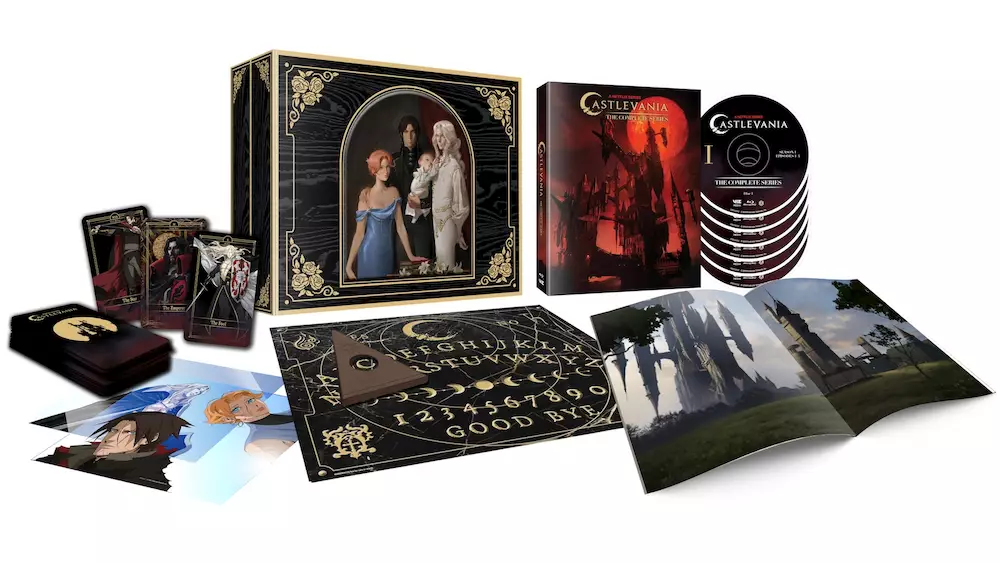In the realm of collectible media, limited edition box sets often serve as the holy grail for passionate fans, promising exclusivity and a tangible connection to their favorite series. The upcoming release of *Castlevania: The Complete Series Limited Edition* exemplifies this desire — a luxurious, intricately packaged collection that aims to elevate the viewing experience into an art form. Nevertheless, beneath the shiny veneer lies a puzzling question: Is the hefty price tag justified? Or is it merely a marketing ploy exploiting fans’ devotion?
The $155 price point for a box set of four seasons, spanning just over 13 hours of content, raises eyebrows. When individual seasons can be purchased on sale for less than $20, the value proposition becomes suspect. This price disparity underscores a core tension in the world of physical media — the allure of exclusivity versus genuine appreciation for quality content. Do collectors truly need the ornate artifacts like tarot decks, Ouija boards, and art books? Or do these items inflate the perceived value, making fans willing to pay a premium for trophies rather than necessity?
Are Collectibles a Justifiable Investment or a Marketing Ruse?
What makes this limited edition intriguing isn’t just its content but its presentation. The faux-woodgrain box, detailed gold embellishments, and curated extras give it an aura of craftsmanship. In an age where digital streaming dominates, physical collections are increasingly rare and coveted. For die-hard enthusiasts, such items transcend mere media; they become symbols of loyalty and fandom identity.
Yet, from a strictly consumer standpoint, the economics don’t favor the typical viewer. When considering the cost, one must scrutinize whether the collectible components, including the art book and game board, genuinely enhance the experience or are simply added distractions. The bonus features on the discs, like galleries and interviews, are valuable but not uncommon. They don’t justify a nearly $100 markup over just purchasing seasons piecemeal.
This raises broader questions about the ethics of pricing strategies in collectible media. Is the manufacturer’s aim to provide enduring value or to capitalize on scarcity and fandom fervor? Given that Blu-ray prices generally decline over time, premium editions often serve as initial cash grabs, promising discounts down the line. Customers need to approach these releases with critical eyes — understanding that paying premium prices upfront doesn’t necessarily equate to better value.
The Artistic and Cultural Significance of Castlevania
Castlevania’s appeal extends far beyond its merchandise; it signifies the renaissance of adult animated storytelling rooted in classic video game lore. Its success lies in its dark tone, complex characters, and striking visuals, which echo the golden era of animated series that push artistic boundaries.
The series’ longevity and popularity reveal a fandom hungry for mature, well-crafted narratives. The art book, *The Art of the Animated Series*, complements this by showcasing the creative process behind the series, making it a worthwhile purchase for aficionados who appreciate the craftsmanship behind animation. Similarly, standout extras like storyboards and interviews deepen fans’ understanding of the show’s development, adding to its cultural value.
However, the question remains: does owning a physical box set with these extras translate into a better appreciation of the series? For many, the answer is yes. For others, it’s a superficial desire to possess what is ultimately digital content. As streaming remains the dominant mode, physical media’s role is transforming from necessity to luxury. When so much of the show’s artistry resides in its digital aesthetic, the tangible extras serve more as collectibles than essential viewing supplements.
The Future of Fandom in a Digital Age
The release of *Castlevania*’s box set underscores a larger trend: a nostalgic longing for physical artifacts amidst a digital world. While streaming offers convenience and affordability, collectors value the physicality, the craftsmanship, and the displayability of these editions. Yet, this cultural shift raises concerns about accessibility and affordability for fans who may not wish to spend hundreds on limited editions.
Moreover, the stark contrast in pricing between the comprehensive box set and individual seasons fuels debates on consumer fairness. The possibility that the high-priced box will eventually be discounted reminds us that these editions often serve as marketing tools rather than necessity. Fans should be cautious, weighing their appreciation for the series against the real-world cost.
Ultimately, owning *Castlevania* on Blu-ray can be a rewarding experience, but it demands a discerning eye. Fans must decide whether they value the collectibles, extras, and aesthetic appeal enough to justify the expense. As the media landscape evolves, so too does our understanding of what it means to truly “own” art. In the end, the heart of fandom lies in passion—passion that should be driven by genuine love for the series, not a desire to own expensive trinkets.

